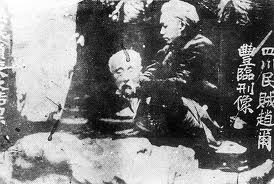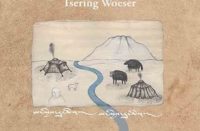High Peaks Pure Earth has translated a blogpost by Woeser written in July 2011 for the Tibetan service of Radio Free Asia and posted on her blog on August 4, 2011.
Woeser’s article focuses on the historical figure of Zhao Erfeng, known as the last Qing Amban in Tibet. Although Woeser has mentioned Zhao Erfeng in previous blogposts, this is the first article to focus solely on him. Woeser also mentions Chinese scholar Wang Hui, High Peaks Pure Earth readers shouldn’t miss Woeser’s previous article about Chinese scholars on Tibet titled “Who Are The Real Orientalists?”.

Zhao Erfeng was a late Qing Dynasty Imperial Minister in charge of the Sichuan-Yunnan border area and also of troops stationed in Tibet; between 1905 and 1908 he sent his army into the eastern Tibetan Kham region to brutally stop Tibetan protests; he also put into effect the abolishment of the hereditary Tusi system and with it the the establishment of the “Liuguan” system to forcefully assimilate Tibet. Tibetan people felt deep hatred towards him, referring to him as “Shadpa Zhao”, which means murderous butcher.
According to records, Zhao Erfeng first “destroyed Qigou Village of Batang County, killed several hundred Tibetans, and threw their dead bodies into the Yangtze River; then he cut out the hearts of the several leaders of the rebellion and strained their blood”. After that he “burned down Sampel Ling Monastery of Chatreng County and Chode Monastery of Batang County for no reason and threw all Buddhist statues, bronze ware, cast copper coins and sacred texts into the toilet; The coloured silk cloths protecting the deities were taken by soldiers and used for foot-binding. It is hard to tell how many innocent people were murdered and slaughtered. But it reached the point where those who escaped into all directions were left destitute and homeless”.
At the end of the last century, the American Christian Priest and medical doctor, Albert Shelton, went to the Eastern Tibetan Kham region to offer medical services and to do missionary work; in his diary, he recorded that Zhao Erfeng’s army put many Tibetan monks and common people into a big pot inside the monastery that was used to make tea, boiled them to death and then fed them to the dogs. Some others were given to the yaks with their limbs tightly tied together to be ripped into pieces and eventually beheaded. Again others were sprinkled with boiling hot oil and thus burned to death.
An executioner who not only murdered people like scything flax but also in the same undignified way destroyed Tibetan culture, has been regarded as supreme by Chinese officialdom. The Party Committee member of the Foreign Affairs Bureau of the Tibet Autonomous Region, Ma Jinglin, said: “with regards to the specific course of events and the specific measures implemented by Zhao Erfeng, no matter what social class one comes from or whether the methods were or were not correct, we need to analyse, understand, and grasp what happened in the context of the particular times and environment at the time. As long as what he did was in tune with the inevitable laws of historical development, we should give him full approval.” This kind of explanation was also used for the massacre on Tibetans in the 1950s, and also during the bloodbath in 2008.
Scholars and writers from within the Chinese system also think highly of Zhao Erfeng; one example is the Han Chinese writer Ma Lihua who lived in Tibet for over twenty years and who became famous by writing books on Tibet; in one of her books she says: “when a dynasty comes to an end, it is possible that a regional general who acts in such a way appears” and then infallibly adds “later on, even though overall, Tibetans spoke badly of Zhao Erfeng, a third of them couldn’t help but express their respect”. A postgraduate student from Minzu University of China studying Tibetology even published a paper under the crude title of “Zhao Erfeng: the Hero of Kham”.
When one searches for “Zhao Erfeng” online, one is confronted with many thought-provoking phenomena. Many Chinese mention that Zhao Erfeng killed Han Chinese people, which they consider the “dark spot in his life”, but his evil behaviour in Tibet is endlessly being praised; one finds headlines such as “the misunderstood national hero of the last century”, “the historical contributions of the great Qing minister Zhao Erfeng who led an army into Tibet to put an end to the rebellions”, “cherish the memory of the national hero Zhao Erfeng”, or “recapturing a Tibetan hero”. This very clearly shows that killing Han Chinese is cruel and mean, whereas killing Tibetans is an act of patriotism.
The Tsinghua University professor Wang Hui recently published a book about the “Tibetan Issue”. In this book he skilfully sums up Zhao Erfeng’s bloody assimilation of Tibet as a kind of “response”: “In 1908, after the imperial minister in charge of the Sichuan-Yunnan border area pacified the armed rebellion in the Kham region, he implemented a large-scale Liuguan system on the Sichuan border (western Kham) (…) what needs to be said is: ‘the new policies’ were put into practice in direct response to and with the aim to control British colonialists who had invaded the Tibetan area.” A friend on Twitter commented: “It seems that the Brits are really to be pitied, not only did they betray Tibet for their own advantage and gained their bad reputation for that, now they are also used as the scapegoat and an excuse for the subsequent colonialists to invade Tibet”.
Precisely as another Twitter friend writes: “In the field of the history of borderland regions and ethnic groups, the voices of the descendants of minority groups hardly carry any weight, history writing remains tightly in the hands of the Chinese (Han) writers who are deeply influenced by the opinions of Chinese officialdom. Problems of distorting the truth or misrepresenting facts are becoming more and more widespread”. Wang Hui cites extensive sources in his book, incessantly providing facts over facts; yet, what is missing are the voices of the Tibetans; even if there are a few, they only work to support his points. Why is this the case? Simply put, these people are not only nationalists, they are nationalists in support of a totalitarian dictatorship.
July 2011





Very tragic. It's hard to imagine what Tibet has had to endure.
Chao was the butcher. Ofcourse, there is no doubt about the fact that he mercilessly murdered, mutilated thousands of Tibetans. We shall never forget that. For all the accusations made by China about the evil landlords and aristrocrats and monks…chao no doubt takes home the gold medal for cruelty. Chinese nationalists either can't comprehend the pain suffered by Tibetans or they just dont care at all.
You mean like how the Tibetan Lamas butchered Tibetan converts to Christianity, French Priests and Han officials before Zhao responded to them exactly the way they started the uprising?
https://en.wikipedia.org/wiki/1905_Tibetan_Rebellion#Attacks_on_Christian_Missionaries_and_Converts
Pingback: The Art of (China’s) Colonialism: Constructing Invisibilities in (Tibetan) History and Geography «
It is laughable how it is not mentioned that those lamas who Erfeng fought had led a bloody revolt against foreigners and converts (both tibetan and chinese), killing and torturing them. This is stated and documented even on Wikipedia… Who are you trying to cheat?
https://en.wikipedia.org/wiki/1905_Tibetan_Rebellion#Attacks_on_Christian_Missionaries_and_Converts